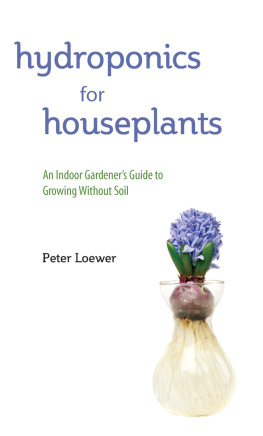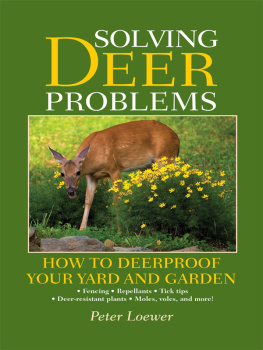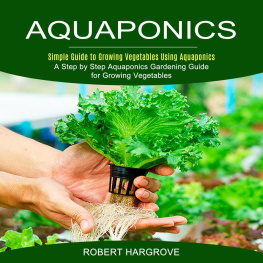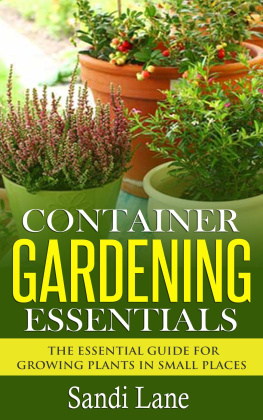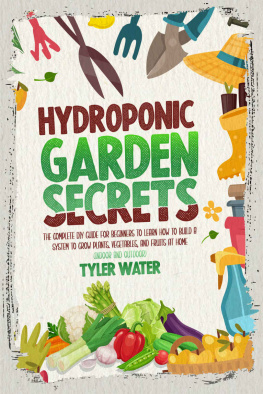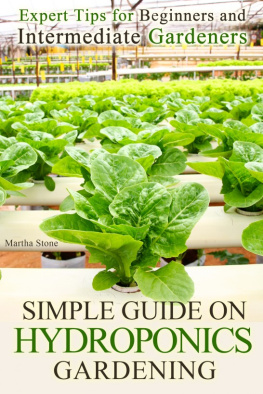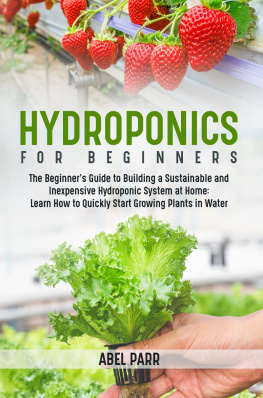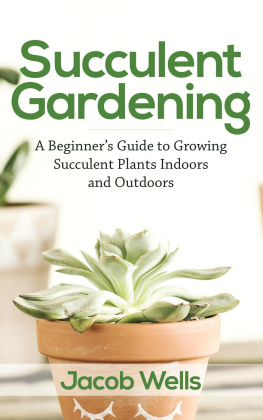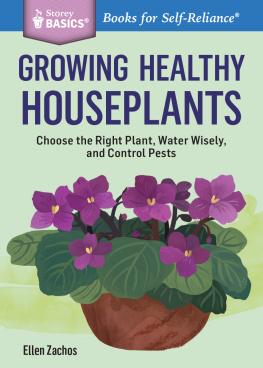Dedicated to Jean, who keeps track of it all!
And thanks to my editor, Kristin Kulsavage, for her excellent help along the way.
Copyright 2016 by Peter Loewer
All rights reserved. No part of this book may be reproduced in any manner without the express written consent of the publisher, except in the case of brief excerpts in critical reviews or articles. All inquiries should be addressed to Skyhorse Publishing, 307 West 36th Street, 11th Floor, New York, NY 10018.
Skyhorse Publishing books may be purchased in bulk at special discounts for sales promotion, corporate gifts, fund-raising, or educational purposes. Special editions can also be created to specifications. For details, contact the Special Sales Department, Skyhorse Publishing, 307 West 36th Street, 11th Floor, New York, NY 10018 or .
Skyhorse and Skyhorse Publishing are registered trademarks of Skyhorse Publishing, Inc., a Delaware corporation.
Visit our website at www.skyhorsepublishing.com.
10 9 8 7 6 5 4 3 2 1
Library of Congress Cataloging-in-Publication Data is available on file.
Cover design by Qualcom Designs
Cover photo credit: Peter Loewer
Print ISBN: 978-1-63450-492-8
Ebook ISBN: 978-1-5107-0165-6
Printed in the United States of America
Table of Contents
Preface
Initially, this book got its start many years ago when my wife and I came from the green fields of a rural community in upstate New York to rediscover all the bling and glitter that a big city has to offer. We settled in the Lower East Side of Manhattan, four flights up, into a small floor-through apartment with two windows facing an airshaft and two front windows facing the street. Our front door was made of some legendary wood with a frosted-glass window reinforced with chicken wire, and there was not a piece of clover in sight.
After the first three months of a typical New York winter, we needed something to remind us of our country heritage and decided to buy a few house plants to brighten our home environment. Since variety stores in our neighborhood were few and far between, we visited a local florist and bought a Christmas pepper ( Capsicum annuum ), the florist having told us that Nothing on Gods green earth can kill them!, a mother-in-laws tongue ( Sansevieria trifasciata )also called a snake plant, a rather limp philodendron of unknown parentage, and an African violet ( Saintpaulia ionantha ).
Like most newly-arrived New Yorkers, we spent most of our free time away from the apartment, and the steam heat began to have its effect: the violet leaves turned brown and crinkled up, despite endless soakings in the sink. In fact, one evening, in darkness (the bathroom light was inoperable; it was behind the door, which had to be left open to admit heat from the kitchen as the landlord had completely overlooked any source of warmth for the bathroom) I neglected to notice that Jean had placed the plants in the tub for a needed soak. One blast from the shower, and a great deal of soil went down the drain and up the walls.
After cleaning up, we went foraging for soil from Central Park and filled a small brown paper bag with needed dirt, which we smuggled home on the subway.
Upon repotting with what turned out to be real (and tainted) soil, some insectsincluding white fliesarose from their winter slumber and tore the pepper to shreds.
Then, in late March, the heat inside the apartment soared to 95 with the windows and the hall door open. The plants were parched. Because the cold-water pipes had broken that afternoon and no one in the building had cold water, we put pans of hot water in the refrigerator to cool, but to no availthe plants expired.
Upon moving to our next apartment, I remembered my mothers garden and her endless plant cuttings, quietly rooting in old jelly glasses filled with water on the kitchen window sill and enclosed back porch. Why not just grow our plants in water? There would be no pots, no dirt, and no daily watering. We wouldnt have to transform the bathroom or kitchen into a potting shed.
We started with some ivy cuttings donated by a Long Island friend, and from then on, at first in the city, then more recently in our Asheville home, our water garden has been growing and growing.
Why Water?
Hydroponics, or hydroculture (growing plants in water), has a history of over 300 years, from the first experiments by the English botanist John Woodward (who endeavored to discover how plants received their nutrients from soil) on to the giant glass and plastic, fully automated, factory greenhouses of the twenty-first century, where vegetables from watercress to tomatoes are grown commercially by the ton.
On a more homely scale, the Sunday supplements of the late 1930s had many readers believing that a small tank near the kitchen would soon produce all the vegetables, fruits, and salads needed by a healthy, modern family.
By the 1940s, popular magazines and newspapers predicted that whole armies would be fed by plants grown without soil in food factories that operated twenty-four hours a day, using giant sunlamps to replace the sun. Visions of super squashes danced in the heads of farmers (released from toil in the fields) and vegetable buyers in box stores alike.
Even today, hydroponic speculations conjure up elaborate spaceship gardens that utilize the wastes of the crew for the necessary carbon dioxide and nutrients to produce extra-terrestrial fruits and juicy algae.
For earth-bound gardeners, the promise of hydroponics is more modestand much closer at hand. The satisfactions of water gardening are available to anyone who likes a bit of greenery in the home all year round and who will spare five minutes a week for the care of their plants. No doubt any reader who picks up this book has tried his or her hand with houseplants. No doubt you have had some success, but those successes, unless you have an uncommonly green thumb, have been mixed with frequent failures. And Ill wager that most of your failures can be traced to one single problem: improper watering!
Before I took up hydroponics, I found I invariably missed one of my house plants on my watering rounds. I thought I had everything down to a perfect schedule: plant X gets water once a week only in the summer (except on rainy days) and in the winter when the leaves begin to droop, plant Y gets water twice a day, and plant Z gets water on the first day of spring. Suddenly, Id have to go away for a few days and return to find not only X, but Y and Z as well, in small heaps on desiccated soil.

An attractive centerpiece made from an old glass battery jar, clear glass marbles, and rooted cuttings of an umbrella plant, Chinese evergreen, ribbon plant, gold-dust Dracaena , and a wandering inch plant.
With water gardening, I just make sure all the vessels are full before leaving and return in a week, or even two, to find all leaves lush and green.
Not only does the practice of hydroponics substantially increase your success as an indoor gardener, it also makes you a wizard decorator as well. The decorative possibilities of the plants and their root systems forming fantastic patterns in the glassware are endless. If you need a unique centerpiece for a dinner party, while setting the table, just go to your water garden and remove two or three plants of pleasing colors and textures, wash them roots and all, then combine them in an attractive jar or vase, add a few glass marbles or pebbles for supportand waterand you have it madewithout a costly trip to the florist.

